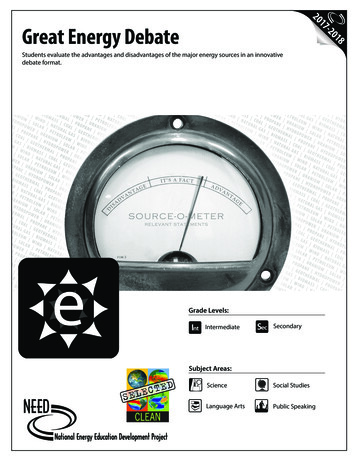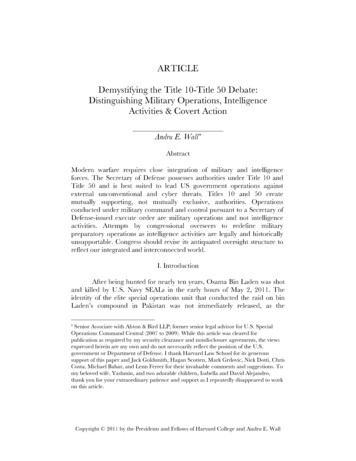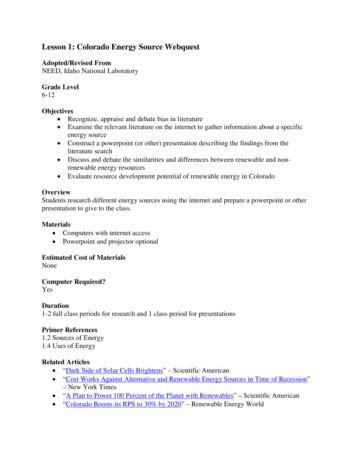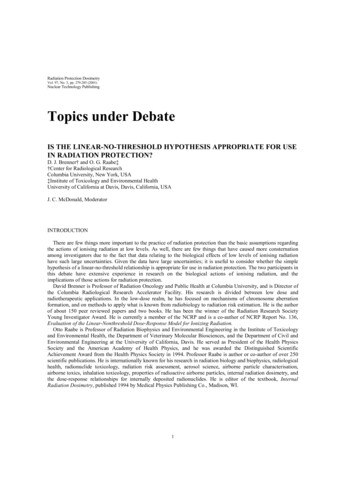
Transcription
2017Great Energy DebateStudents evaluate the advantages and disadvantages of the major energy sources in an innovativedebate format.eGrade ecSubject Areas:ScienceSocial StudiesLanguage ArtsPublic Speaking-2018
NEED Mission StatementThe mission of The NEED Project is to promote an energyconscious and educated society by creating effectivenetworks of students, educators, business, government andcommunity leaders to design and deliver objective, multisided energy education programs.Teacher Advisory BoardPermission to CopyConstance BeattyKankakee, ILBarbara LazarAlbuquerque, NMJames M. BrownSaratoga Springs, NYRobert LazarAlbuquerque, NMNEED curriculum is available for reproduction by classroomteachers only. NEED curriculum may only be reproducedfor use outside the classroom setting when express writtenpermission is obtained in advance from The NEED Project.Permission for use can be obtained by contactinginfo@need.org.Amy Constant - SchottRaleigh, NCLeslie LivelyPorters Falls, WVTeacher Advisory BoardNina CorleyGalveston, TXJennifer Mitchell WinterbottomPottstown, PAShannon DonovanGreene, RILinda FonnerNew Martinsville, WVSamantha ForbesVienna, VAMichelle GarlickLong Grove, ILErin GockelFarmington, NMRobert GriegolietNaperville, ILBob HodashMollie MukhamedovPort St. Lucie, FLDon Pruett Jr.Puyallup, WAJudy ReevesLake Charles, LATom SpencerChesapeake, VAIn support of NEED, the national Teacher Advisory Board(TAB) is dedicated to developing and promoting standardsbased energy curriculum and training.Energy Data Used in NEED MaterialsNEED believes in providing teachers and students with themost recently reported, available, and accurate energy data.Most statistics and data contained within this guide arederived from the U.S. Energy Information Administration.Data is compiled and updated annually where available.Where annual updates are not available, the most current,complete data year available at the time of updates isaccessed and printed in NEED materials. To further researchenergy data, visit the EIA website at www.eia.gov.Jennifer TrochezMacLeanLos Angeles, CAWayne YonkelowitzFayetteville, WVDaNel HoganTucson, AZGreg HolmanParadise, CA1.800.875.5029www.NEED.org 2017Printed on Recycled Paper2Great Energy Debate
Great Energy DebateTable of Contents¡ Standards Correlation Information4¡ Teacher Guide5¡ Game Board8¡ Energy Source Debate Sheets9¡ BiomassNEED is proud to announce thatthis guide is a part of the CLEANCollection! The Climate Literacy andEnergy Awareness Network, or CLEAN,is a nationally recognized project ledby science and education experts tosupport climate and energy educationthrough the collection of educationalresources. CLEAN resources are peerreviewed by educators and scientistsas well as annotated and alignedwith standards and benchmarks. ThisNSF, DOE, and NOAA funded projectis an excellent library of learningactivities, visualizations, videos, andinvestigations. To learn more aboutCLEAN, view other activities in theCLEAN Collection, or to join the CLEANcommunity, visit http://cleanet.org/clean/about/selected by CLEAN.9¡ Coal10¡ Geothermal11¡ Hydropower12¡ Natural Gas13¡ Petroleum14¡ Propane15¡ Solar16¡ Uranium17¡ Wind18¡ Evaluation Form19e 2017 The NEED Project8408 Kao Circle, Manassas, VA 201101.800.875.5029www.NEED.org3
Standards Correlation Informationwww.NEED.org/curriculumcorrelationsNext Generation Science Standards This guide effectively supports many Next Generation Science Standards. This material can satisfy performance expectations,science and engineering practices, disciplinary core ideas, and cross cutting concepts within your required curriculum. For moredetails on these correlations, please visit NEED’s curriculum correlations website.Common Core State Standards This guide has been correlated to the Common Core State Standards in both language arts and mathematics. These correlationsare broken down by grade level and guide title, and can be downloaded as a spreadsheet from the NEED curriculum correlationswebsite.Individual State Science Standards This guide has been correlated to each state’s individual science standards. These correlations are broken down by grade leveland guide title, and can be downloaded as a spreadsheet from the NEED website.4Great Energy Debate
eTeacher Guide& BackgroundGrade LevelsIn Great Energy Debate, student teams learn about all of the energy sources, then are assigned torepresent one specific energy source. Working cooperatively, students develop arguments on themerits of their source over the others. Intermediate, grades 6-8 Secondary, grades 9-12 Time ObjectiveStudents will be able to list and identify the economic and environmental advantages anddisadvantages of the major energy sources. Concepts We use ten major sources of energy in the United States.Two or three 45-minute classperiods (If you have limitedtime, see Alternate Procedure onpage 7.) Additional Resources Some energy sources are nonrenewable; others are renewable. Energy is used for transportation, heating, cooking, manufacturing, and making electricity. Some energy sources affect the environment more than others. Some energy sources provide a lot of the energy used in the U.S.; others provide only a small amount. Some energy sources provide energy at a low cost; others are more expensive. MaterialsUse NEED's Energy Infobooks,available for free download atwww.NEED.org, for more indepth information about eachenergy source. Energy Infobooksare available at the intermediateand secondary levels. A set of Energy Source Debate Sheets for each team (For younger students, you can use simplifieddebate sheets found in Energy in the Balance, available online at www.NEED.org.) A set of YES/NO signs for each of the judges Great Energy Debate Game Board on page 8, or download an Excel version from www.NEED.org2 Preparation Decide how many energy sources you will be using, depending upon the number of students in theclass or group. For large groups of 30 or more, you can use all ten energy sources. For smaller groups,choose fewer energy sources. Each group should have a minimum of three students. Make one copy of each of the Energy Source Debate Sheets you will be using for each group. If you are using fewer than ten energy sources, make copies of the Energy Source Debate Sheets thatyou are not using. Complete these sheets as a class after you introduce the activity. This will ensurethat the students understand the concepts of advantages/disadvantages and learn about all of theenergy sources. Ask three colleagues, school administrators, community leaders, or parents to serve as judges forthe debate. If volunteers are not available, you may assign three students to serve as judges. Make sets of YES/NO cards for the judges. 2017 The NEED Project8408 Kao Circle, Manassas, VA 201101.800.875.5029www.NEED.org5
ProcedureStep One: Introduce Unit to the Class Introduce the Great Energy Debate to the class, using the concepts as a guide.Step Two: Monitor Group Work Once students are in their groups, explain the procedure. Answer any questions they have about the activity. If you are not using all tensources, use the extra debate sheets you are not using to explain the procedure. Have the groups complete the sheet for their assignedsource first. This should take about five minutes. Have the groups complete the sheets for the other groups' energy sources. This should take about twenty minutes.Step Three: Debate Begin the game by giving the teams the following instructions: The object of this game is to be the first team to reach the top of the game board. The game is played in rounds. Each team is given theopportunity to move its token up by stating an advantage of its energy source. You may instead choose to move an opponent’s tokendown by stating a disadvantage of the opponent’s energy source. Teams will present their advantages or opponent disadvantages to a panel of judges. An opposing team can object to the presentedstatement. The opposing team must convince the judges that the statement is not an advantage. The team that stated the advantagewill then have the opportunity to defend its position. The judges may vote in favor of the defending team or presenting team. Ifthey agree with the presenting team's stated advantage, that team will move up one. If they vote in favor of the defending team, thedefending team moves up one position and the presenting team moves down one space. Or, the judges may decide the statement isjust a fact. In this case, the defending team stays in its original position. If a team states a disadvantage to try to move an opposing team down, then the opposing team can defend itself without penalty. Thestating team does lose position if judges side with the opposing team. Ask the first team to give an advantage or disadvantage. Action continues until one team reaches the top line, until time is called, or untileach team has had the opportunity to begin a round. DAY ONE—complete the first round. DAY TWO—finish the remaining rounds.Step Four: Interpret the Debate Results At the conclusion of the debate, point out that all sources of energy have advantages and disadvantages. Ask the class thefollowing questions: Why isn’t there an obvious winner in this debate? Even if the debate continued, would there be a winner? Why or why not? Why do we use energy sources that have negative impacts on the environment? What are some other factors that we need to consider in our choice of energy sources?6Great Energy Debate
Great Energy Debate - Alternate Procedure2 Preparation Make one set of Energy Source Debate Sheets for each student, plus an additional set for each group. Make a copy of the Great Energy Debate Game Board, or download the Excel file from www.NEED.org to project. Make a copy of one of the debate sheets to project and explain the procedure, if necessary. Make sets of YES/NO cards for the judges.ProcedureStep One: Introduce Unit to the Class Introduce the Great Energy Debate to the class, using the concepts as a guide. Distribute one set of debate sheets to each student. Explain the procedure for completing the sheets, projecting a sample, if necessary. Instruct the students to complete all of the debate sheets individually as classwork or homework.Step Two: Monitor Group Work Decide who will be in each of the groups. If your students are not used to working in groups, you may want to give them guidelines forgroup work. Place students into groups. Distribute a set of debate sheets to each group. Have the students complete the debate sheets as a group,using their individual sheets as guides. This should take about thirty minutes. Let students know which source they will tackle as a group.Step Three: Debate Use the instructions set forth under Step Three on page 6.Step Four: Interpret the Debate Results Use the instructions set forth under Step Four on page 6.SAMPLE1.Coal is one of the most abundant fuels in the United States. We have over a 280 year supply based onthe current rate of consumption.2.Although coal is still being formed today, we use it thousands of times faster than it is formed.3.Coal generates 33 percent of the electricity in the U.S. 2017 The NEED Project8408 Kao Circle, Manassas, VA 20110DISADVANTAGEIT’S A .org7
eBiomassCoalGeothermalHydropowerNatural TAGESSTART HERESTART HEREDISADVANTAGESDISADVANTAGES8Great Energy Debate Game BoardGreat Energy Debate
1.Biomass is a source of energy from plant materials and animal waste.2.Biomass is a renewable energy source; we can grow more biomass.3.Biomass is difficult to store and transport because it decays.4.As biomass decays, more of its energy is available for use as fuel.5.Biomass was the first source of energy harvested and used by humans.6.Some of the carbon dioxide created by burning biomass can be absorbed by planting new biomass.7.The amount of energy stored in biomass is less than the amount of energy stored in anequivalent weight of a fossil fuel.8.Biomass can be used as a fuel because it captures and stores radiant energy from the sun through theprocess of photosynthesis.9.Less than 3% of American homes use biomass (burn wood) as their only heat source.DISADVANTAGEIT’S A FACTBiomassADVANTAGERELEVANCE10. Biomass is abundant and can be produced almost everywhere in the U.S.11. Burning biomass can produce odors and emissions.12. Burning biomass in a waste-to-energy plant produces a small amount of U.S. electricity.13. Biomass provides 4.9 percent of the nation’s total energy demand.14. Today, about 44 percent of biomass energy comes from wood.15. The pulp and paper industries use waste wood to generate steam and electricity, meeting over half oftheir own needs.16. Biomass can be made into ethanol and biodiesel, transportation fuels that are cleaner-burning thanunleaded gasoline and traditional diesel.17. Alcohol fuels made from biomass can be domestically produced.18. Mixing 10 percent ethanol with gasoline produces E10, a cleaner-burning fuel used nationwide.19. Burning biomass in a waste-to-energy plant reduces the amount of garbage sent to landfills.20. Waste-to-energy plants use scrubbers and other technologies to reduce emissions and odors. 2017 The NEED Project8408 Kao Circle, Manassas, VA 201101.800.875.5029www.NEED.org9
1.Coal is one of the most abundant fuels in the United States. We have over a 280 year supply based onthe current rate of consumption.2.Although coal is still being formed today, we use it thousands of times faster than it is formed.3.Coal generates 33 percent of the electricity in the U.S.4.The U.S. exports about 8.3 percent of the coal it produces to other countries.5.Coal has been burned to cook food and heat living spaces and water for thousands of years.6.Today, over 90 percent of the coal consumed in the U.S. is used by the electric power sector to generateelectricity.7.When coal is burned, carbon dioxide, sulfur dioxide, nitrous oxide, and other pollutants are produced.8.To remove coal buried deep in the earth, mine shafts are constructed to bring the coal to the surface.9.An easier way to mine coal near the earth’s surface is to remove the layers of earth to uncover the coal.This is called surface mining.DISADVANTAGEADVANTAGECoalIT’S A FACTRELEVANCE10. Large amounts of land are disturbed in the process of surface mining.11. Surface mines can be restored to grasslands or parks after the coal is removed.12. About one-third of the nation’s coal is produced from underground mines.13. The water that filters through abandoned mines can pick up chemicals that pollute the water if themines are not closed correctly.14. Coal is used to smelt iron into steel and by the paper and building supply industries.15. Coal can be turned into a gas to make it burn cleaner. This process is expensive.16. Coal mining can be dangerous for miners due to gases and explosion hazards.17. Ash from coal plants can be recycled and used for cement additives, roadway materials, and even inhabitat restoration for oysters.18. Some cleaner coal technologies require less coal to produce the same amount of electricity.19. The methane gas that is found around much of the coal in the U.S. is a valuable resource.20. The electricity industry uses items like scrubbers to reduce harmful emissions from coal plants.10Great Energy Debate
1.Geothermal energy comes from heat within the Earth.2.Examples of geothermal energy are hot springs, volcanoes, and geysers.3.Geothermal energy is generated in Earth’s core, which is made of magma (molten iron) surrounding asolid, mostly iron core.4.Red hot temperatures are maintained inside the Earth because of the slow decay of radioactiveparticles found in all rocks, and the immense pressure on the core.5.Geothermal energy is renewable. The hot water used by power plants is replenished by precipitationand the geothermal heat is continually produced.6.Wells can be built to pump super-heated water to the surface.7.Geothermal energy is used to produce electricity and to heat and cool buildings.8.Geothermal energy was used by ancient people for heating and bathing. Hot springs are said to havetherapeutic effects today.9.In 1904, the Italians first used steam erupting from the earth to power a turbine generator.DISADVANTAGEIT’S A FACTGeothermalADVANTAGERELEVANCE10. Dry steam reservoirs are the most efficient for producing electricity, but they are very rare.11. The United States generates more electricity from geothermal than any other country in the world.12. High temperature geothermal resources capable of producing electricity are not economically availablein all parts of the nation.13. The most active geothermal resources are found along major tectonic plate boundaries, where magmacomes very near Earth’s surface.14. Geothermal energy produces less than one percent of the electricity consumed in the nation today.15. Geothermal energy does little damage to the environment because geothermal power plants sit on ornear the geothermal reservoirs and do not burn any fuel.16. Geothermal steam and hot water contain traces of hydrogen sulfide and other gases, as well aschemicals that are harmful at high concentrations.17. The gases and chemicals from geothermal power plants are usually reinjected into the Earth.18. The temperature of the earth a few feet underground remains constant year round—about 52 degreesFahrenheit in moderate climates.19. Low temperature geothermal energy is available everywhere in the U.S. for heating and cooling homes.20. Geothermal heat pumps use the Earth’s constant temperature as an energy source to heat buildings inwinter and cool them in summer. 2017 The NEED Project8408 Kao Circle, Manassas, VA 201101.800.875.5029www.NEED.org11
1.Moving water has been used as a source of energy for thousands of years.2.Hydropower is considered one of the cleanest and cheapest energy sources in widespread use today.3.Moving water is a renewable energy source.4.Moving water can turn a turbine to generate electricity.5.Hydropower was first used to turn water wheels to grind grain.6.Hydroelectric power is reliable because dams can be built to store water. Controlling the flow of thestored water allows a power plant to operate in all weather conditions and at times of greater electricaldemand.7.About 5-10 percent of total U.S. electricity is generated by hydropower plants, depending on theamount of rainfall.8.Hydropower provides the U.S. with about 2.4 percent of our total energy consumption.9.In the last 60 years, hydropower production in the United States has increased by 63 percent.DISADVANTAGEADVANTAGEHydropowerIT’S A FACTRELEVANCE10. The nation’s largest producer of hydroelectric power is the Federal Government, which operates manylarge dams and power plants.11. There are about 2,200 hydroelectric power dams in the U.S. today.12. There are about 81,800 dams that do not have generating plants on them.13. New construction and improvements at existing hydropower plants could increase our hydroelectriccapacity by 30,000 to 60,000 MW by 2025.14. When a hydropower dam is built, thousands of acres of nearby land are flooded to create a reservoir.15. Projects using wave and tidal energy to generate electricity are being tested and used in a fewlocations in the U.S. and around the world.16. Dams can disturb the migration and spawning of fish populations in the river.17. Dams can alter the natural flow of the river and change the amount of water that reaches communitiesdownstream.18. Reservoirs that result from construction of a dam are often developed for recreational purposes, suchas boating and fishing.19. The use of conventional hydropower in the U.S. is not expected to increase significantly in the future,but wave and tidal projects are expected to increase.20. Some countries use hydropower as their main source to produce electricity. Norway produces 96percent of its electricity from hydropower.12Great Energy Debate
1.Natural gas was formed from the decomposition of tiny sea plants and animals that lived hundreds ofmillions of years ago.2.Natural gas is mostly made of a chemical called methane.3.Natural gas is odorless; an odorant called mercaptan is added for safety.4.Natural gas can be processed and other products, like propane and the materials in plastics, can berecovered from it.5.Natural gas is considered to be the cleanest-burning fossil fuel. It produces almost no sulfur or nitrogenoxides.6.Natural gas and petroleum are often found together in underground deposits.7.In the past, oil drillers were not interested in the natural gas that was found at the site of an oil well.Today, it is as valuable as the oil.8.The invention of high pressure pipelines has made it possible to transport natural gas all over the U.S.9.Leaks can occur in natural gas pipelines. Fires and explosions can result from these leaks if proper safetyprecautions are not taken.DISADVANTAGEIT’S A FACTNatural GasADVANTAGERELEVANCE10. About 5.5 percent of the natural gas we produce comes from federal offshore wells in the Gulf ofMexico.11. Natural gas is a nonrenewable resource.12. Today, the U.S. has a large supply of natural gas. There are also large reserves of natural gas offshore, onthe outer continental shelf, and in the Gulf of Mexico.13. Natural gas is used almost equally by homes and businesses, industry, and for electric powergeneration.14. Natural gas can be used as a cleaner-burning transportation fuel.15. Natural gas supplies will likely last about 93 years at today’s prices and consumption rate.16. Natural gas accounts for 29.0 percent of total U.S. energy consumption.17. If a higher price is charged for natural gas, supplies could last as long as 200 years.18. Roughly half of the homes in the U.S. use natural gas as their main heating fuel.19. Natural gas is used to produce peak load electricity because natural gas furnaces can be brought online and shut down quickly and efficiently to generate steam for electricity.20. Burning methane produces carbon dioxide. Both methane and carbon dioxide are greenhouse gasesthat trap heat energy. Increasing the levels of greenhouse gases in the atmosphere can affect the globalclimate. 2017 The NEED Project8408 Kao Circle, Manassas, VA 201101.800.875.5029www.NEED.org13
1.The word petroleum is derived from the word petro, meaning rock, and the word oleum, meaning oil.2.Petroleum deposits were formed over hundreds of millions of years from the remains of marine plantsand animals.3.Petroleum is a nonrenewable energy source.4.Oil deposits are found in many areas, onshore and offshore.5.The U.S. imports about 48 percent of the petroleum it uses from other countries.6.The U.S. has large petroleum deposits in Alaska and offshore.7.Many offshore resources are off-limits to development due to state and federal regulations.8.One-sixth of the oil the U.S. produces comes from offshore wells, mostly in the Gulf of Mexico.9.Petroleum straight from the well—crude oil—is not usable. It must be refined into gasoline and otherproducts.DISADVANTAGEADVANTAGEPetroleumIT’S A FACTRELEVANCE10. Petroleum refining uses the boiling points of different hydrocarbon molecules to separate them fordifferent uses.11. We get many fuels from refining petroleum—gasoline, kerosene, jet fuel—that can be burned toproduce heat, light, electricity, or motion.12. Many chemical products from petroleum can be used to make plastics, medicines, fertilizers, and otherproducts.13. When petroleum products are burned, harmful emissions are produced.14. To protect the environment, oil drilling and production are regulated by federal and state governments.15. Oil is transported by pipeline, truck, or tanker to where it is refined and/or used.16. If oil is spilled into the water or onto the land, it can cause damage to the environment.17. Petroleum products are efficient, economical transportation fuels. Most transportation in the U.S. isfueled by petroleum products.18. Today, gasoline powered vehicles produce fewer emissions than they used to, due to advances inengine design and fuel formulation.19. Petroleum is the leading source of energy in the U.S., supplying 36.6 percent of the energy used in theU.S.20. At current rates of consumption, there is at least a 23 year worldwide reserve of petroleum.14Great Energy Debate
1.About half of the propane we use comes from natural gas processing, and half from petroleum refining.We import about 11 percent of the propane we use.2.Under normal conditions propane is a gas, but under moderate pressure or low temperature, propanebecomes a liquid.3.Propane is stored as a liquid in pressurized tanks because it takes up 1/270 of the space it occupies as agas, and is very portable.4.Propane becomes a gas when it is released from the pressure in the tank. As a gas, it is used to fuelappliances.5.Like natural gas, propane is colorless and odorless. An odorant called mercaptan is added as a safetymeasure.6.Propane is a nonrenewable energy source.7.Propane is a cleaner-burning fossil fuel.8.Propane is moved through pipelines to distribution terminals.9.Propane is taken from distribution terminals to bulk plants by trains, trucks, barges, and supertankers.Local dealers fill their small tank trucks and distribute it to their clients.DISADVANTAGEIT’S A FACTPropaneADVANTAGERELEVANCE10. Propane is mostly used in rural areas that do not have reliable access to utilities. Homes and businessesuse it for heating, hot water, cooking, and clothes drying.11. Farms rely on propane to dry crops, power tractors, heat greenhouses, and warm chicken houses.12. Propane is also used by taxicab companies, government agencies, and school districts to fuel theirvehicles.13. As a vehicle fuel, propane is cleaner-burning than petroleum and leaves car engines free of deposits.Engines fueled by propane also have fewer emissions.14. There is a slight drop in miles per gallon when propane is used to fuel vehicles instead of gasoline.15. Propane is not widely used as a transportation fuel because it is not as conveniently available asgasoline or diesel.16. An automobile engine must be adjusted to use propane.17. Propane gas is heavier than air and can explode if the propane is ignited.18. Propane is more expensive than natural gas, heating oil, or kerosene.19. Propane is often used to power indoor vehicles such as forklifts.20. Propane supplies and price are tied to oil and natural gas supplies and costs. 2017 The NEED Project8408 Kao Circle, Manassas, VA 201101.800.875.5029www.NEED.org15
1.The sun radiates more energy in one day than the world can use in a year.2.The sun is a star made up mostly of hydrogen and helium gas. It produces radiant energy in a processcalled nuclear fusion.3.Harnessing radiant energy from the sun is difficult because the energy that reaches the Earth is veryspread out.4.Only a small part of the solar energy radiated ever reaches the Earth.5.It takes the sun’s energy just over eight minutes to travel 93 million miles to the Earth.6.Solar energy is a renewable energy source.7.Solar energy is used to heat passive solar buildings and water and to generate about one percent ofU.S. electricity.8.The amount of solar energy reaching an area depends on the time of day, season of the year, cloudcoverage, and geographic location.9.Solar water heaters can reduce energy bills by half when installed.DISADVANTAGEADVANTAGESolarIT’S A FACTRELEVANCE10. A solar collector can be used to capture sunlight and change it into usable heat energy.11. An active solar home in the Northern Hemisphere uses special equipment on the south side of thebuilding to absorb sunlight and change it into thermal energy. Air or water flows through the collectorand is warmed by the energy inside.12. Passive solar homes do not depend on mechanical equipment to transform radiant energy into thermalenergy.13. Photovoltaic cells can convert radiant energy from the sun directly into electricity.14. Concentrated solar power technology uses reflective mirrors to focus solar energy, producing hightemperatures and generating electricity.15. Photovoltaic—or PV—systems have a long payback period because of their initial cost.16. PV cells are used to power homes, roadside telephones, calculators, and toys, and work well for items inremote locations.17. Crystalline silicon PV cells convert about 16 percent of the energy they receive into electricity.18. Electricity from PV cells has a cost range of 0.12-0.30/kWh. The average cost of electricity (generatedmostly from fossil fuels) in the U.S. today is about 0.127 cents/kWh.19. Large solar systems can take up a large amount of land or can be placed on large, flat roofs.20. Solar energy does not pollute the air.16Great Energy Debate
1.In 1939, scientists discovered that certain atoms could be split. The splitting of these atoms releases agreat amount of energy.2.Ninety-nine nuclear power reactors at 61 plants operate in the U.S.3.Nuclear plants provide 19.4 percent of the electricity generated in the U.S.4.A nuclear reactor can supply a large amount of energy using a very small amount of fuel.5.The construction of nuclear power plants is very expensive compared to fossil fuel plants.6.Nuclear reactors do not burn uranium or fuel to generate electrical power. They split the uraniumatoms—so their emissions are minimal.7.Uranium is easy to transport.8.Uranium is inexpensive.9.The U.S. has abundant supplies of uranium. However, we import most of the uranium used in powerplants because it is cheaper than mining it.DISADVANTAGEIT’S A FACTUraniumADVANTAGERELEVANCE10. Nuclear power plants produce electricity by heating water into steam in the same way as fossil fuelplants.11. Workers at nuclear power plants receive less radiation from the plant
Ask three colleagues, school administrators, community leaders, or parents to serve as judges for the debate. If volunteers are not available, you may assign three students to serve as judges. Make sets of YES/NO cards for the judges. e Teacher Guide Grade Levels Intermediate, grades 6-8










